We have much more to do and your continued support is needed now more than ever.
Ten Years After the BP Oil Spill, Restoration Offers Hope for the Gulf

This blog post is co-authored with colleagues from National Audubon Society, the National Wildlife Federation, The Nature Conservancy, and Ocean Conservancy.
On April 20, 2010, the BP Deepwater Horizon oil rig exploded, killing 11 men and spewing an estimated 200 million gallons of oil into the Gulf of Mexico over the following 87 days. It was the largest oil spill in U. S. history, and it wreaked incredible harm on the ecosystem, wildlife and communities of the Gulf.
Such a large and damaging spill necessarily triggered extraordinary legal action. The resulting record-setting legal settlements are funding what is arguably the largest ecosystem restoration effort in history. From the global settlement, $16 billion was directed toward restoration. More than $12 billion remains to be invested — a process that will not be completed until 2032.

Although an impressive sum, $16 billion is still not enough to address the myriad problems facing the Gulf, particularly with the looming threat posed by climate change. Because of that, it is imperative that we make the most out of every dollar available.
For years, our five organizations have worked collectively and with partners to advance projects that will make the most difference and to ensure that the money is spent in a way that is transparent and based on sound science.
To date, all levels of government have acted diligently together, across jurisdictions and party lines to create tangible benefits for communities and wildlife. This money will restore the Gulf ecosystem as a whole with projects in all five states and in the open ocean. For example:
- Barrier islands are nature’s first line of defense against storms and they provide important habitats for birds and sea turtles. But the Gulf’s barrier islands are eroding rapidly due to sea-level rise and sand starvation — a process that was sped up by the oil spill. Settlement funds have rebuilt and restored barrier islands in Alabama, Louisiana, Mississippi, Texas, and Florida.
- More than 50,000 acres of beautiful and ecologically important coastal lands across the Gulf region are now protected, permanently providing habitats for wildlife and creating new recreational opportunities for coastal communities.
- The Louisiana coastline experiences one of the most rapid rates of coastal land loss anywhere in the world — threatening a particularly rich ecosystem. The State of Louisiana, the Federal Natural Resource Damage trustees, the National Fish and Wildlife Foundation and the Army Corps of Engineers are working on projects to allow the Mississippi River to once again replenish coastal marshes and swamps with fresh sediment. Restoring these wetlands and building new ones through natural delta building processes will also help protect the New Orleans area and other coastal communities from future hurricanes and sea level rise.
- Oysters are nature’s kidneys — filtering water and improving its quality and clarity. Furthermore, oyster reefs provide important habitat for fish, crabs, birds and other wildlife, and can provide wave protection for fragile marsh shorelines. Sadly, oysters have been on the decline in the Gulf for decades — and more than eight billion oysters perished as a result of the oil spill and the response. Settlement funds are rebuilding and restoring oyster reefs in estuaries across the Gulf.
- Projects called “living shorelines” use natural features such as wetlands, dunes, and oyster reefs to help protect coastlines from sea level rise while creating and protecting habitats for wildlife. Settlement funds are building these types of projects across the Gulf — the Lightning Point project in the fishing port of Bayou LaBatre, Alabama is one good example.
- Marine species from birds, to sea turtles, whales and dolphins and fishes and deep ocean habitats are the focus of the largest open ocean restoration initiative ever undertaken. The innovative, science-based approaches will help commercially and recreationally important reef fish rebuild their populations through voluntary use of special devices that improve post-release survival and benefit deep sea corals through expanded seafloor mapping and novel propagation techniques.

Ten years after the spill, the accomplishments are real and offer hope for the future of the Gulf.
This enormous progress is a direct result of dedicated funding, governments working together, bipartisan support, science guiding investment, and involvement from diverse stakeholders at the grassroots level. As a result, the Gulf has demonstrated that Americans can deliver tangible and lasting benefits for our wildlife, our coast and our communities.
Visit our educational 10 Species, 10 Years Later website to learn about habitat restoration efforts to recover wildlife after the Deepwater Horizon disaster.
Learn more





















